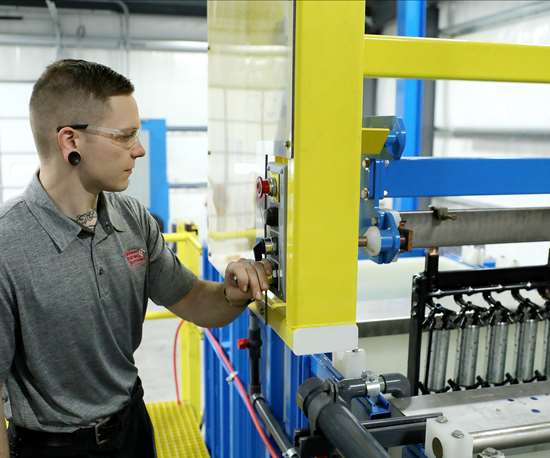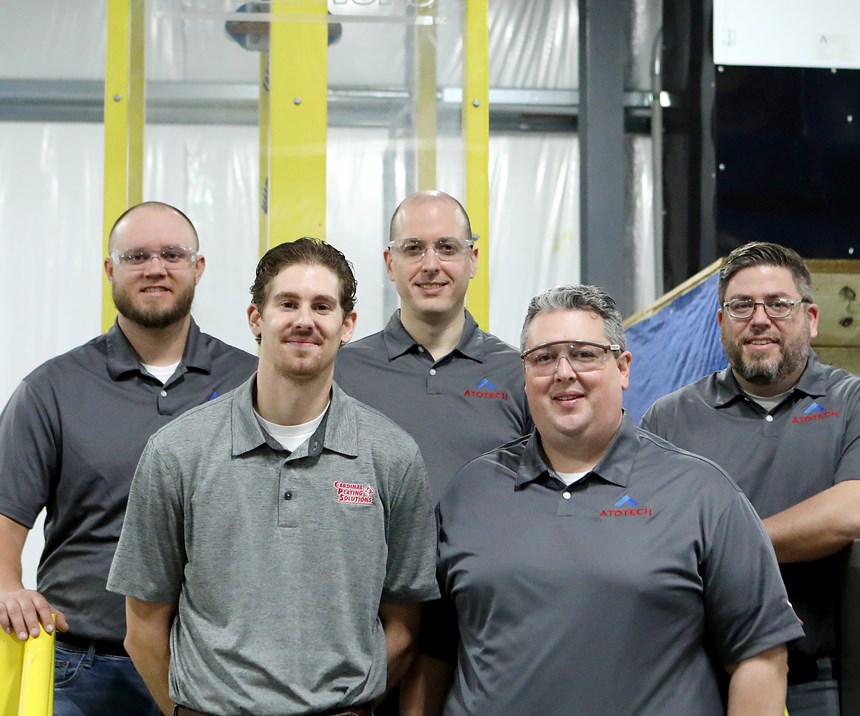Drive about 200 miles west of Chicago to the town of Aledo, Illinois, and you will run into what could be the future of electroplating. In December, Cardinal Plating Solutions in Aledo installed what it says is the plating industry's only full-scale, production-ready functional trivalent chrome line. It uses Atotech’s BluCr chemistry, which has a Vickers Pyramid Number deposit hardness in line with industry requirements, but also the potential of increasing through post finishing.
Chris Shull, Cardinal’s president, says the company spent more than a year working with Atotech on planning and installing the line after deciding they could branch out to grab new business from companies that need a hard-chrome application.
“We’ve come across several local opportunities with customers who have a demand for chrome,” Shull says. “But we didn’t want to mess with the obligations that come with a traditional hexavalent deposit.”
Caleb Morrison, Atotech’s North American business development manager for functional chrome and electroless nickel (EN), was already working with Cardinal on EN chemistry and told Shull about the new BluCr chemistry they had been fine-tuning and running on a beta site for three years.
That led to testing parts at Atotech’s Rock Hill, South Carolina, research facility, all of which led to great results for Cardinal and the expansion of their facility to accommodate a new line.
“This is the first North American production installation,” says Caleb Morrison, Atotech’s North American business development manager for functional chrome and electroless nickel. “We truly think this will be industry shifting.”
Automotive, Hydraulics, Construction and Agriculture
John Kochilla, Americas vice president and managing director for Atotech North America, says the BluCr product is ideally suited for automotive applications, hydraulic rods and in the construction and agriculture industries.
“Significant monetary and time investments were made in the development of this technology. The time portion can be measured in decades not just in years,” Kochilla says. “It is important that the market understands that, as a part of our development process, end users have already field tested components with BluCr. Process validation is a routine step in our product development process, benefiting our customers and end users.”
Kochilla and Atotech were at the forefront decades ago in helping to replace hex chrome in corrosion-resistant passivation applications for zinc and aluminum, decorative-plated finishes and, more recently, in plating on plastic pretreatment. Naturally, the request to replace hex chrome in the functional/wear-resistant plating applications have been on the horizon for many years, especially with regulators and OEMs calling for the move from the product.
“We had to do our diligence and, with many development programs, there were a lot of rabbit holes we went down that bore no fruit for us,” he says. “This is a product the industry is calling for and we’re happy to put it into the hands of people in the market who can build or grow their business with it.”
Morrison says the low friction and good wear-resistance properties of BluCr make it simple to replace hex hard-chrome coatings for many applications. He says it utilizes a nickel underlayer that helps the new chemistry easily outperform the corrosion resistance of single-layer, hex-chrome finishes.
Cardinal Plating Solutions hosted an open house for existing and potential customers to show off the new facility and line.
“Being in the heartland of the country, most of the demand we are seeing for this product is being driven by agriculture and construction,” Shull says. “We already have relationships with John Deere and Caterpillar in electroless nickel, and they and others are the ones who have voiced an interest in getting a local chrome supplier. We feel the work is there, and now we have an opportunity to go after it.”
For information, visit cardinalplatingsolutions.com and atotech.com.
RELATED CONTENT
-
Plating Q&A: Can you color stainless steel?
Our expert, Art Kushner, says yes, you can color stainless steel, but it is not a process that is typically performed in a plating shop. Read more about his answer.
-
Anodizing for Bonding Applications in Aerospace
Anodizing for pre-prep bonding bridges the gap between metallic and composite worlds, as it provides a superior surface in many applications on aluminum components for bonding to these composites.
-
Cleaning, Pretreatment to Meet Medical Specs ISO 13485 or FDA 21 CFR820
Maximilian Kessler from SurTec explains new practices for industrial parts cleaning, metal pretreatment and decorative electroplating in the medical device industry.



















